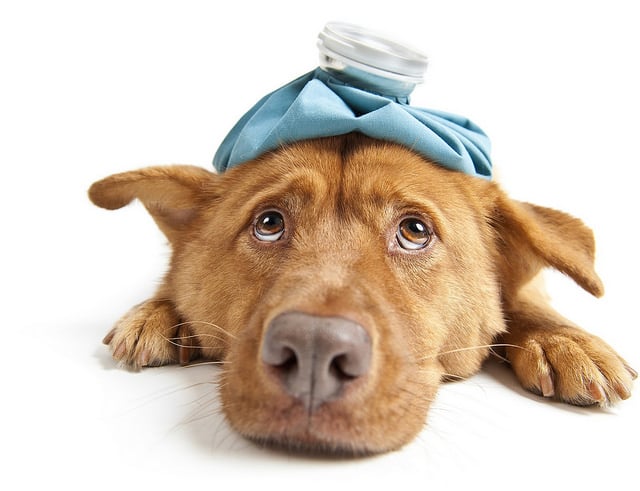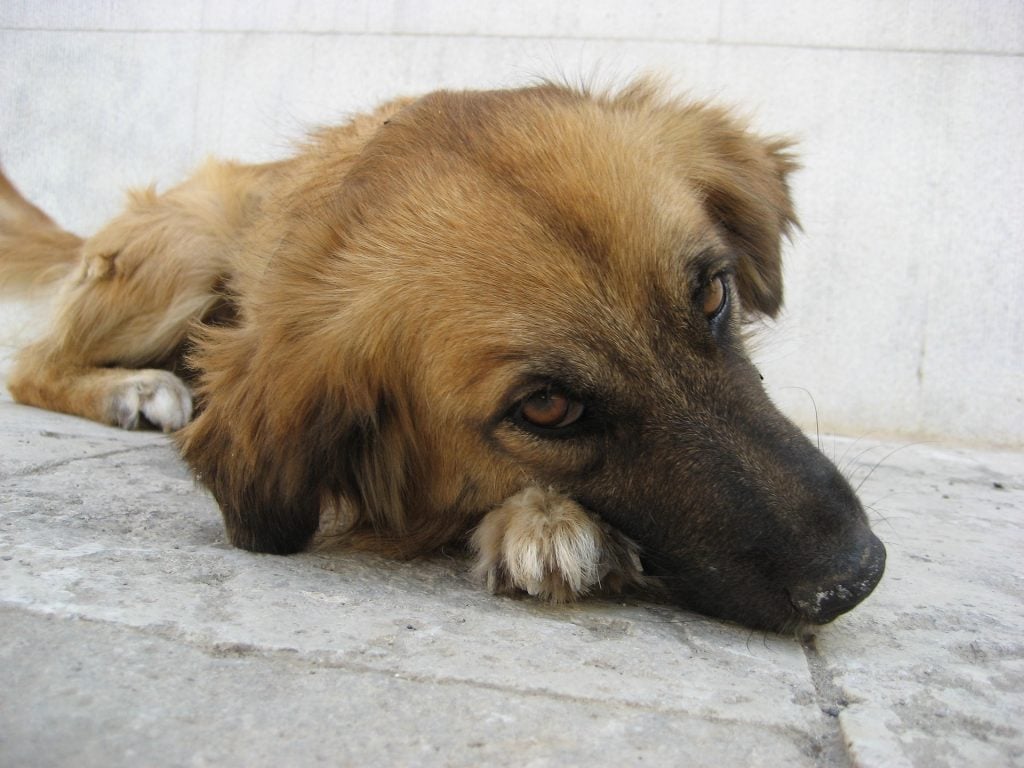Anyone who’s ever watched the flu make its way around the office can tell you how often a person’s environment can affect their health. But can the same thing happen in dogs? Can you pass a cold to your dog? Could he be negatively affected by a product you use in your home? Could you be inadvertently getting him sick?
The answer is yes — but don’t worry, you have more control than you realize! This guide will discuss canine colds, allergens and other environmental risk factors, plus go over some precautions and adjustments to make your home a safe atmosphere for you both. Always consult your veterinarian with questions, and seek professional assistance immediately if your dog appears to be exhibiting symptoms of illness.
From your sinuses to his: can you transmit illness?
Perhaps one of the only true comforts while you’re sick with the flu is having your pup right by your side. Snuggled up in bed, surrounded by discarded tissues and enduring the occasional sneezing fit, you probably don’t think much about passing your germs on to your four-legged companion. Unfortunately, the flu virus tends to spread through moisture from sneezing, coughing, or talking, so between the sniffly kisses and the verbal praise you’re showering him with, your dog might be catching more than just your affection.
While reverse zoonosis — the transmission of illness from human to animal — is rare, some doctors worry about pet exposure to influenza. Interspecies transmission of a virus sometimes creates a more harmful or easily transmissible mutation to occur. This can be especially dangerous with the influenza virus, which is able to evolve pretty easily.
There’s also the canine flu to consider, also known as H3N8. This is mostly a concern if you have multiple dogs, or if your dog is regularly exposed to other pooches (like doggie daycare or frequent trips to the dog park). Dogs have no natural immunity to the virus, and can be easily spread by an infected dog panting, sneezing, or licking another dog or shared toy. It can even be transmitted passively through you: if you were to (unknowingly) pet or play with a sick dog and then interact with yours, you could pass along the virus. Luckily, most cases are pretty mild and can be treated by your veterinarian if caught in time.
Symptoms of influenza in dogs are very similar to those seen in humans:
- Runny or stuffy nose, nasal discharge, and/or difficulty breathing
- Coughing
- Watery eyes
- Loss of appetite
- Lethargy
- Fever
Image via Pixabay
There is an H3N8 vaccine, but it only protects against certain strains of the virus. On average, it costs about $100 for the full treatment, so if your dog has limited exposure to other dogs (be it direct or passive exposure) it may not be worth the expense. Keep in mind that the vaccine is only preventative and can’t treat him once he’s infected.
Whether you think it’s a flu he caught from you or one he caught from another dog, take your dog to the vet immediately if you think he may be sick. He may or may not need medication to treat a possible respiratory infection, and your doctor may even set him up with some fluids if he’s dehydrated from not drinking enough water.
Environmental factors
Believe it or not, even dust mites can make your dog sick if he’s allergic — and unfortunately, it’s very common in dogs! Dust mites thrive in warm, moist air, so you might find them in your carpet, bedding, furniture, even in cloth toys. They tend to target the most sensitive hosts: those with allergies have different skin lipids than their allergy-free counterparts, which seem to be a delicious delicacy for mites.
Your dog might be struggling with an allergy to dust mites if he exhibits:
- Irritated skin (may look like seborrhea)
- Excessive scratching, especially around the face and feet
- Skin infections
- Ear infections and inflammation
Your vet will have to make the official diagnosis of a dust mite allergy and reaction in your pet, so if he’s regularly showing any of these signs, you should take him in for a checkup as soon as possible. Once he’s diagnosed, you can work with the vet to come up with a practical treatment plan, the first step of which will likely be to rid your home of mites.
Invisible to the naked eye (they’re both microscopic and translucent), it’s nearly impossible to tell if there are dust mites in your home. They feed on bacteria, viruses, fungi, and dead skin they find in their environment, so keep this in mind while cleaning around the house. Vacuuming at least once a week can make a significant difference in getting rid of them, and be sure to concentrate in places where he spends a lot of time: his bed, his preferred corner of the couch, the mat his food and water bowls sit on, and anywhere else he tends to favor.
Image via Pixabay
Next, consider the kinds of products in your home. It probably doesn’t seem like they’d much affect your dog’s health, but he’s susceptible for a couple of reasons: to start, he’s in closer proximity. Most dogs lick crumbs from the floor (which may have lingering toxic cleaner on them), sniff the carpet (and potentially anything it has absorbed or gathered), and lie against the wall (which could be invisibly coated with anything from hairspray to pesticide). Second, canine grooming behaviors are much different than those of a human: a dog uses its tongue to clean itself, passively ingesting anything that could be on its fur or skin. Dogs also don’t know to avoid inhaling that air freshener you just spritzed or not to chew your been-everywhere, stepped-in-who-knows-what shoes.
Altogether, your dog is at risk for contact with allergens through both touch and accidental ingestion, so it’s important to know what kinds of products he’s exposed to every day. You may be surprised to learn how many dangerous common household products are out there, but don’t get overwhelmed. There are lots of safe, natural alternatives that you can transition to, and in the meantime, clean strategically. For example, if you have multiple bathrooms, use your bleach cleaners for the master shower, but a non-toxic product for the tub where you bathe your dog.
Prevention
The first step in protecting your pup from unwanted germ exposure is to be wary when you’re feeling under the weather. It doesn’t mean you can’t pet or snuggle your pet at all while you’re sick, but treat him as you would your partner: be affectionate, but modest. Wash your hands as much as possible (that’s good advice for anyone who’s sick, pet parent or not!) and resist the urge to smother him in kisses. Be mindful of the garbage — use trashcans with a lid when possible — and keep him toward your lap or feet instead of right by your face. It might be a slight adjustment, but just remember that you’re sparing him from the same misery!
Once you’re back on your feet, it couldn’t hurt to do a little cleaning to get rid of any lingering germs that, though you’re now immune to, your pup isn’t. Opt for pet-safe cleaning products as much as possible, and regardless of toxicity level, always store cleaning supplies (including mops, sponges, and other utensils) completely out of your pet’s reach. Vacuum carpets weekly and dust mop or sweep hard floors every few days; if your dog is a breed with thick or long fur, or if you have multiple dogs, you may want to even make it a daily routine. Consistent vacuuming can not only capture dust mites from carpets, curtains, and furniture, it can cut back on overall allergens that could be bothering your pet.
Image via Pixabay
In general, be a little more mindful about how, where, and when you use products in your home. If your pup likes to watch you apply makeup in the morning, does he lick up that excess powder from the floor? If so, consider draping a towel over your lap while applying or switching to the bathroom mirror so the sink catches any debris. If you like visitors to be met with a crisp, pleasant aroma upon entering your home, switch to a natural home freshener instead of aerosols, and try to keep your dog’s exposure to it to a minimum — spray while he’s in another room or place it somewhere high where he won’t constantly walk by at nose-level. Never leave supplies in easy reach, even for a moment, while you’re cleaning. It only takes a moment for your dog to sprint away with a bleach-dipped scrub brush, so don’t give him even a second of opportunity.
Talk to your vet about additional measures you can take to prevent your dog from getting sick. Not only will he know about regional allergens and illnesses, he’ll likely have numerous patient testimonials and recommendations that will help you decide what’s right for your pet. With the right cleaning, upkeep, and thoughtful consideration, it’s easier than you might think to keep your dog malady-free.





